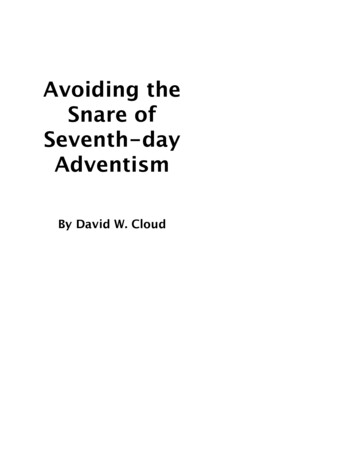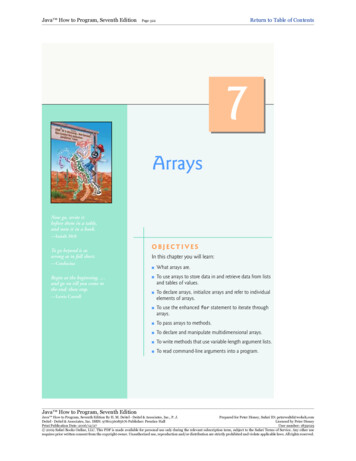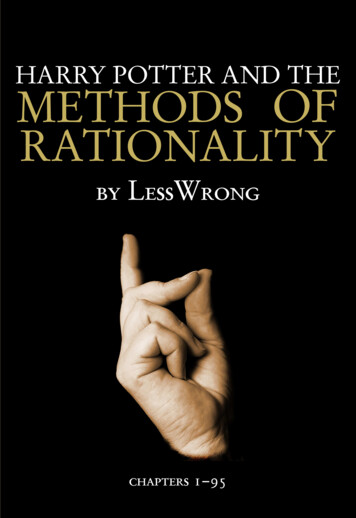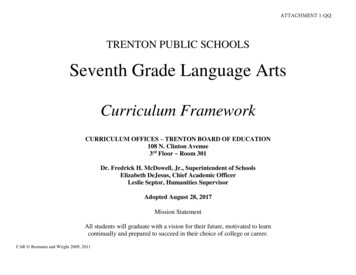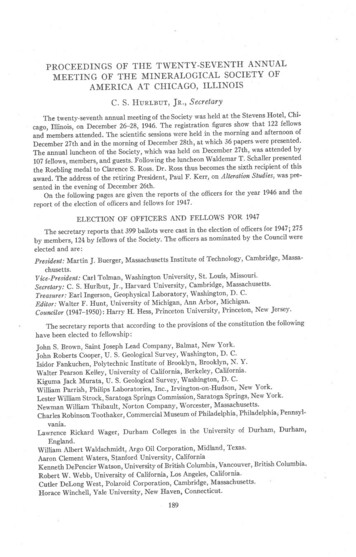
Transcription
PROCEEDINGS OF THE TWENTY-SEVENTH ANNUALMEETING OF THE MINERALOGICAL SOCIETY OFAMERICA AT CHICAGO, ILLINOISC. S. Hunrnut, Jn', SecretarYHotel, ChiThe twenty-seventh annual meeting of the society was held at the Stevensthat 122 fellowscago, Illinois, on December 2618, 1946. The registration figures showofattended. The scientific sessionswere held in the morning and afternoonoJ -"-b"rspapers were presented.December 27th andin the morning of December 28th, at which 36was attended byThe annual luncheon of the Socieiy, which was held on December 27th,T. Schaller presented107 fellows, members, and guests. Following the luncheon waldemarrecipient of thisthe Roebling medal to clarence s. Ross. Di. Ross thus becomes the sixthStuilies' was preaward. The address of the retiring President, Paul F. Kerr, on Alterationsented in the evening of December 26th.year 1946 and theOn the following pages are given the reports of the officers for the'1947lotfellowsandofficersofreport of the electionELECTIONOF OFFICBRSANDFELLOWSFOR 1947lot 1947;275The secretary reports that 399 ballots were cast in the election of officersthe Council wereby members, 12i by fellows of the Society. The officers as nominated byelected and are:Cambridge' MassaPresident: Martin J. Buerger, Massachusetts Institute of Technology,chusetts.Vice-Presiilent: Carl Tolman, Washington University, St' Louis, Missouri'Massachusetts'Secrelary: C. S. Hurlbut, Jr., Harvard University, Cambridge,Treasurer: Earl Ingerson, Geophysical Laboratory, Washington, D' C'Etlilor: Walter F. Hunt, University of Michigan, Ann Arbor, Michigan'New Jersey'Courui.!'or (1947-1950): Harry H. Hess, Princeton University, Princeton,the followingThe secretary reports that according to the provisions of the constitutioniellowshiP:have been elected toBalmat, New York'John S. Brown, Saint Joseph Lead Company,john Roberts Cooper, U. S. Geological Survey, Washington, D' C'isidor Fankuchen, Polytechnic Institute of Brooklyn, Brooklyn, N' Y'Walter Pearson Kelley, University of California, Berkeley, California'Kiguma Jack Murata, U. S. Geological Survey, Washington, D' C'York'Wiltiam Parrish, Philips Laboratories, Inc., Irvington-on-Hudson, NewYork'Lester William Strock, Saratoga Springs Commission, Saratoga Springs, NewNewman William Thibault, Norton Company, Worcester, Massachusetts'Philadelphia; PennsylCharles Robinson Toothaker, Commercial Museum of Philadelphia,vania.Durham' Durham'Lawrence Rickard Wager, Durham Colleges in the University ofEngland.William Albert Waldschmidt, Argo Oil Corporation, Midland, Texas'Aaron Clement Waters, Spanford University, CaliforniaBritish columbia.Kenneth DePencier watson, university of British columbia, rsityRobert W. Webb,Cutler Delong West, Polaroid Corporation, Cambridge, Massachusetts'Horace Winchell, Yale University, New llaven, Connecticut'189
190C. S. HURLBUT, JR,REPORT OF THE SECRBTARY FOR 1946To the Council of the Mineralogical Society of America:Mnlrnrnsrrrp 7T1172643rI44The above figures show a net gain of 19 fellows. Sixteenmembers r,vereelected to fellowship; four fellows were reinstated and one, G. F. Loughlin,u,as lost through death. A netgain of 76 members and 191 subscribers gives atotal gain of feilows, -"-b".and subscribers for 1946 oI 287- This brings the grand total to 1403,again a new high recotd.The large gain in subscribers and to a lesser extentthe gain in members was broughtabout by the increase in foreign subscriptions andthe reinstatement of foreign members,particularly from the Soviet Union.Respectfully submitted,C. S. Hunlsur, Jn., SecretaryREPORTOF THEEDITORFOR 1946To the Council of the Mineralog,i,col,Soeiety oJ America:During the current year, practicaly all colreges anduniversities have experiencedunprecedented student enrollments. The teaching staffs, onthe other hand, have not beenincreased in the same ratio. This unbalanced adjustmenthas resulted in large classesandheavy teaching assignments which have consumed muchof the spare tim"e and energythat under more normal conditions might have been spent planninginresearch in new fieldsor continuing projects already begun.rrowever, in spite of these handicaps, a sufficientry large numberof papers have beenreceived to insure a volume for 1946 of slightly moiethan 600 pages, oi an average ofabout 100 pages for each of the six bimonthry issues. Thisaccomplishment might beconsidered as fairly satisfactory under the present prevailingconditions.The current voiume is somewhat smailer than that of a yearago, but it shourd be recalled that the previous vorume contained a special symposiumnumber of 14 papers onquartz oscillator-plates. The inclusions of tlris 264-pagespecial issue was largely responsiblefor the enlarged size of the volume for 1945. In this connection,it .right b" .roted ihat thedemand for this symposium number has been so greatas to require a reprinting of 150copies of that issue by a lithoprinting process.The Geological Society has continued its generous financiarsupport for defraying a substantial portion of the publication costs of our journal. This past year,this aid amountedto 2500 r'"ith an additionar appropriation, not to exceed 500, for the cost of colored pratesif and when such illustrations were deemed desirabre.Recognition and deep appreciationis here expressed for this generous and timely assistance,by virtue of which it was possibreto include two colored inserts during the year. A corored prateis also planned in connectionwith an article by !-' H. Pogue and r. H. Rogers on"Experiments in o-ray irradiationof gem stc'nes," which will appear in theJanuary-February number, now in press. rn thisinstance, Jrowever, the corored insert is being iurnishedtv the li".ht.ttiuioruto.i".,Inc., of SpringCale,Connecticut, u,ithout cost to our Societ.r,.
PROCEEDINGSOF THETWENTY-SEVENTHANNUALMEETINGI9IDuring the summer of the current year) our publishers served notice that due to the increased cost of labor and materials, it would be necessary to terminate our old printingcontract and enter upon a new onelvhich would step up our printing bill about lGl8To.This action was not entirely unexpected, as ,e were all aware of the present trend in prices.The executive committee of our Council, alter a careful study, considered the new ratesreasonable, under present conditions, and voted to continue our cordial relations with theGeorge Banta Publishing company. This company has served our Society without interruption since 1922.From time to time, inquiries have been received as to whethel a single index will beavailable covering the ten-year period from 1936 t}Irough 1945. Through the efforts ofDrs. Ingerson and Fleischer, who have jointly undertaken this task, it can be stated thatthe decennial index is in preparation and probably will be available sometime duringt947.In a detailed analysis of the Journal for 1946, we find that volume 31 contains 606 pages,exclusive of index. Leading articles, which number 46, occupy 78.4/p oI the total space. Table 1, which accompanies this report, indicates the distribution of the leading articles inthe various fields listed. The average length of each of the main articles is only 10.4 printedpages.If to the 46 leading articles we add 17 shorter papers appearing under the heading of,,Notes and News," we obtain a total of 63 published manuscripts for the calendar year'These contributions u'ere received from 80 contributors associated with 38 difierent universities, research bureaus, and technical laboratories.The Jownai lor 1946 carries detailed descriptions of two new minerals: tinticite andmontbrayite. One hundred and eighty-seven illustrations of various types assist in clarifying the descriptive portions of the text. As in previous years, a number of manuscripts u''erereceived from sources outside the States, and in 1946 eight such contributions 'ere printedfrom the following countries: canada 4, and one each from Netherlands, England, southAfrica, and Australia.The accompanying Table 1 summarizes in detail the distribution of subject matter involume 31.
192C. .t. HURLBIJT, JR.Tanr,n 1. DrsrnrsurroN or Sun;rcr Merrnn rN Vor,uur 31SubjectsLeading articles*Descriptive MineralogyCXremical MineralogyStructural Crystallography(leometrical CrystallographyPetrographyOptical MineralogyMemorialsMiscellaneousArti.clesPagesPer Cenl oJ TotalI961l2JI46Shorter articlesNotes and newsProceedings of SocietiesBook reviewsNew mineral names4/5r716 )1ol147012182ls )Total entries113IllustrationsIndex, Title page, Table of contents18760678.42 1. 6100.0t4Grand total620* Leading articles average 10.4 printed pageseach.Respectfullysubmitted,W.a.r,rnnF. HvNr, EilitorREPORT OF THE TREASURER FOR 1946To the Counci,l.of the Mineralogirol Societyof America:Your treasurersubmitsherewith his annual report for the year beginningDecember1,1945,and ending November 30, 1946.RrcrrprsCashon hand Decemberl,1945.Dues and subscriptions. . .Sale of back numbers.Authors' charges on separates.fnterest and dividends from endowment. . .Papnents on principal of Trenton Mortgage stock. .Geological Society of America grant for 1946.Advertisements. . .Aid in publishing special articles.Sale of extra May-June, 1945, numbers.Sale of 20-volume index. 2,647.7O4,187.321, 6 5 6 . 8 6570.313, 132.00130.142,891.40310.85952.00302.79s.00 16,786.37
PROCEEDINGS OF TEE TWENTY-SEVENTEANNUAL MEETING193DrssunsnwNts 6,020.35499.t61,390.00463.48487.s78. 6 82 7.919.6090Printing and distribution of the Journal.Printing and distribution of separatesTo the Editor, Secretary,and TreasurerPostage. . .Clericalhelp.Oflice equipment. .Printing and stationerySafety deposit box. . .Telegram.Committee expenses. cbangeon loreign checksReturnedcheck.Work on index (Vols.21-30). .Riehts for A. T. & T. debentures . . 9,393.557 ,392.82Cash balance November 30, 1946 16,786.37The endowmentfunds of the society as of Novembet 30,1946,consistof the followingsecurities:BoNos 5,190.635M U. S. Treasary,2l/e.3 ,887. 505M Illinois Central, 4/6. .5,743.755M SouthernRailway, 5%. . . . . .5,068. 755M ClevelandUnion Terminal,5%5 , 2 5 7. 5 06M Atlantic CoastLine, 4 %.400.004C Great Northern, 5 /6.Pnerenrro Srocxs5 ,942.5050 shares, Virginia Electric & Power Co., 5/6.37 514/1000 shares, Trenton Mortgage Servicer ,754.48#.CouuoN Srocrs50 shares, Chesapeake& Ohio Railway.50 shares, Pennsylvania Railroad. .25 shares, Standard Oil of New Jersey.25 shares, American Telephone & Telegraph.,2,368.751,468.751,356.253,369.3277 60,080.f Residual value.Respectf ully submitted,E.qrr, IltcnnsoN, Tr easur el
194C. S, HURLBUT, JR.DANAFUNDDisbursements are made to needy minerarogists in war areas, and to needyfamilies oIdeceased mineralogists in war areas.RncnrprsAvailable balance, November 30, 1945Interest 943.396.34 949.7sDrsnursnurursDisbursedAvailabie balance, November 30, 1946. 334.00615.73fi949.73Respectfullysubmitted,Banl fncpnsoN, TreasurerREPORT OF THE AUDITING COMMITTEETo thePresi.d.entoJthe Mineraloghal,SocielyoJAmerila:The Auditing Committeehas examinedand verified the accountsof the Treasurer ofthe Mineralogical Society of America for the fiscal year ending November 30, 1946.Thesecuritieslisted in the Treasurer'sreport, with all future couponson the couponbonds atare in the safetvdepositbox at the Friendship Branch of the RiggsNational Bank!9!ed,of Washington,D. C.Respectfully submitted,Arrow Gennrer,Wrrr-rau T. PoconaEowano p. Hnxonnsox, Chai,rman
ABSTRACTS OF PAPERS PRESENTED AT THE TWBNTYSEVENTH ANNUAL MEETING OF THE MINERALOGICALSOCIETY OF AMERICA, CHICAGO, ILLINOIS'DECEMBER 26-28, t946SOME UNITED STATES BOEEMITE LOCALITIES*I'ICTORT. AIIENU. S. Geological Survey, Washington, D' C'The only boehmite locality in the United States listed in the Seventh Edition of Dana'sMineralogy is incorrectly reported to be the Linwood-Barton district, Georgia' More than200 samples of bauxite and clay from Alabama and Georgia, including some frorn Linwood, Bartow County, Georgia, were examined by *-ray and optical methods and foundto contain gibbsite but no boehmite.Investigation of alumina hydrates of the United States was started wjth a grant fromthe Geological Society of America in 1941 and continued durin g 1942 to 1946 in connectionwith the high-alumina clay project oI the Geological Survey, U. S. Department of the Interior. The boehmite occurrences reported by H. S. McQueen near Swiss and Stolpe,County, California.- P"blt.h"dInterior.by p"rmission of the Director, Geological Survey, U. S. DepartmentofSOME EXAMPLES OF THE DISTRIBUTION OF FLUORINE IN ROCKSTOM I. W. BARTIIUniversity of Chicago, Chicago, IllinoisNew data of fluorine in rocks and thermal emanations are presented. They corroboratet}le earlier conclusions of E. S. Shepherd (1940) that fluorine is not an insignificant coristituent of the earth's crust; he thinks that about 0.04 per cent F is characteristic of plutonic rocks, lavas run lower, alkaline rocks run higher.In the plutonic rocks of the (alkaline) Oslo province the average concentration offluorine is 0.075 per cent (the range is from 0.06.3 to 0.090). In basalts from Iceland ttrefluorine content ranges from 0.002 to 0.040, average 0.017 per cent F. In the Oslo kauaiites(formerly erroneously called essexites) the average is 0.070 per cent F.In the Oslo plutonics fluorine shows no relationship to any other rock-forming element'But in the basaltic rocks very constantly the weight percentage of F is one-tenth that ofP2O5,suggesting that apatite in these rocks is the chief carrier of F.Fluorine in thermal waters of Iceland ranges from z.ero to 1.45 parts per million' Thisis about the same as one finds in river waters, but much lower tJran the figures given byAllen and Da-v from hot-spring waters of Yellowstone'Sinter deposits in Iceland contain 0.003 per cent F. Rocks altered by thermal r,'atersare lorv in fluorine both in Iceland and in the Yellolvstone Park. But one rock (fromHverar6nd, Iceland) highly altered by fumarole gases has as much as 0.480 per cent F'Many more analyses are necessary before the geochemical cycle oI this freakish element will be understood.195
196c. s. ELTRLBUT, JR.EUCEROITEAND ewBradenobservationsMine,on ngary,chemicarand on charcophylriteanalyss5yieldthe fonowingon these minerals:LIROCONITEI. G. BDRRY AND T. DAVISQueents University,GRAMTESOF TIIE FRONT RANGE:TIIE LONGS PEAK-ST.Kingston,PEGMATITESAssocIATEDVRAIN BATHOLITIIMARGARET FUIIERDenver,OntarioBOOSColoradoWITHfromdata
PROCEEDINGS OF TEE TWENTY-SEVENTETHESTRUCTI]REANNUAL MEETING197OF NEPIIELINEM. J. BUERGER, GILBDRT E. KLEIN, AND GABRIDI-LE HAIIBURGDRMassachusettsMassachusettsInstituteof Technology,Cambridge,A Weissenbergstudyof nephelineshows thatit belongsto space group.863 and hascell edges,a:10.05 A and c:8.38 A. The unit cell contains SNaAlSiO4.The intensities of all reflections which can be recorded with filtered copper radiationwere determined using a modified Dawton method. From these data Harker syntheses wereprepared and studied in the implication diagrams l3(ry0) and l6(xyi). This permittedlocation of aII the metal atoms, but the oxygen atoms were insumciently defined to belocated by this method.Assuming tlat the metal atoms alone determin ed the hk\ phases, a preliminary electron-density map, p(xy}), was prepared. This roughly revealed the oxygen locations. Employing the new atomic locations, the signs oI F(hk1) were recomputed and a new electrondensity map was prepared. By successive approximations the r and , parameters \{erearrived at.The z parameters have been studied fust by one-dimensional Harker syntheses'P(r1gp), and later by a series of non-centrosymmetrical electron-density projectionsthroughplanarsections,suchas p(r2/32)and,p(:v0z). .52.52.28.28.82.18o0.33.67.50.75.25.25.75The structure of nepheline proves to be based upon the tridymite structure, with NaAlsubstituted for half of the Si atoms, as originally predicted by Schiebold. The Na1(:I()atoms occupy large holes, and the Nar atoms occupy smaller holes produced by collapseof voids in the tridymite structure. Chemical analyses bear out the view that tu'o of theeight alkali atoms are potassium and not sodium, so that the formula of nepheline is reallyKNagAlrSirOre.The implication diagram 16(11 ) provides evidence for assuming that the atoms onthe three-fold axes are in motion.CRYSTAILIZATION PI{FNOMENA IN VOLCANIC EJECTA FROM KILAUEA, IIAWAIIRANDOIPEW. CIIAPMANThe Johns Hopkins University, Baltimore, MarylandThe eruption of Kilauea volcano in Halr.aii in l:[f:ay 1924 was of particular interest because it involved many violent explosions, phenomena not common to Kilauean activity.During the eruption a large number of angular blocks of lava were expelled from t}levolcano's orifice and scattered over the floor of the caldera around the great frepit, Halemaumau.
198C. S. HURLBUT, TR.One particular rock type is a glass-bearing basalt consisting of microphenocrysts ofolivine and augite set in a groundmass of labradorite, augite, and basaltic glass, with minoraccessories. The labradorite and most of the augite are arranged radialll', forming variolitic structures about 3 millimeters in diameter. Glass fills the interstices between mineralgrains.The texture of the basalt and the paragenesis of its minerals suggest that the normalbasaltic magma, from which it was apparently derived, passed through 3 distinct stages inthe process of cooling. During Stage 1 the magma cooled slowly and developed microphenocrysts of olivine and augite. Stage 2 began when the magma was intruded as a silllike mass into ttre hot walls of the Halemaumau firepit. The magma, now cooling morerapidly, precipitated crystals of labradorite and augite as radial intergrowths. In Stage 3pottions of the intrusion were torn violently from the wall of Halemaumau firepit andhurled high into the air, causing the residual liquid in the pore spaces to be chilled to aglass.DIFFERENTIAL THERMAL ANALYSIS OF SOME CARBONATE MINERALStr.I. CUTEBERTNational Lead Company, Los Angeles, CaliforniaANDR. A. ROMANDShell Oil Company, Houston, TexasDifierential thermal analysis curves are presented for ten of the more common carbonate minerals of knorvn purity. The characteristic curves given should aid in detecting thepresence of these minerals when they occur in clays or soils being analyzed by this method.The use of differential thermal analysis is suggested for industries utilizing carbonate minerals or their by-products.SEARLESITE FROM TEE GREEN RIVER FORMATION OF WYOMING'JosEprr J. rannv (witha-ray analysis by yosnln M. AxErRoD)U. S. Geological Survey, Washington, D. C.Searlesite has been found in the drill core of the John Hay, Jr.,Wellllat a depth of1,480 ieet and in the Union Pacific drill core #4 at 1,706 feet, approximatel5r 18 and 20miles, respectively, west of the City of Green River. This is the third recorded occurrenceof searlesite.Searlesite occurs in low grade oil shale associated with shortite and an undeterminedfibrous mineral. Large anhedral crystals 5 cm. across and up to 3 mm. thick lie parallel tothe bedding of tlle shale.The optical properties of the searlesite from Wyoming agree with those already determined. The indices of refraction were measured in sodium light: a:1.525, 0:1.531, andX-ray difiraction photographs and chemical analysis identify the Wyomingz:1.535.mineral as searlesite.t Published by permission of the Director, Geological Survey, U. S. Departmentthe Interior.ofA SIX-TARGET COLD-CATHODE X-RAY DIFFRACTION UNITE. W. I'AIRBAIRNMassachusetts Institute of Technology, Cambridge, MassachusettsUsing basic designs described by Buerger and Chesley a cold-cathode difiraction unithas been built which, by rotation of a taper sleeve in the side of the tube, gives Cu, Fe, Co,Ni, Cr, or Mo radiation as desired, without disturbance of the operating gas pressure.This feature increases many times the eftciency of work where more than one target is
PROCEEDINGSOF TEETWENTV-SEVENTHANNUALMEETING199essential, such as (1) identification by the powder method of crystalline compounds of widecompositional range, (2) precision determination of lattice constants by the single-crystalmethod. Additional features of this improved equipment are, (1) elimination of autotransformers and rectification valves, (2) use of a transformer instead of a resistor to control the primary current, (3) permanent seals for the windows (beryllium) and for the glassinsulating cylinder, (4) adjustable target-cathode distance, and air-cooling of cathode without a blower, (5) unusually short evacuation line direct to a mechanical pump, with the airintake valve mounted directly on the tnbe, (6) short target-collimator distance and rigidattachment of camera base to frame of tube.THERMAL ANALYSIS OT'THE MAGNESIUM MINERALS OF THE CURRANTCREEK MAGNESITE DEPOSITS, CURRANT CREEK, NEVADA*GEORGET. TAUSTU. S. Geological Survey, Washington, D. C.Thermal analysis methods were used in connection with the study of the mineralogyand petrology of the Currant Creek magnesite deposits of Nevada. The minerals presentare carbonates, hydroxides and basic carbonates and of the hydrous magnesium silicates.Some relationships with other occurrences of related minerals are outlined.* Publishedof the Interior.withthe permissionof the Director,THE UNITGeologicalSurvey,U. S. DepartmentCELL OF GLAUCODOTR. B. FERGUSONUniversity of Toronto, Toronto, OntarioA large typical crystal of glaucodot (Co, Fe)AsS, from Ifakansb i, Sweden, shorvs a goodprismatic cleavage (110) and a poor pinakoidal cleavage (001), in the preferred originalsetting. Rotation and Weissenberg photographs on a cleavage fragment turned about[00t1 show no significant departure from orthorhombic symmetry and lead to a C-typecellwitho:6.63,b:28.33,c:5.63kX, Z:24,G:6.15 (calc.forCo:Fe:1:1),6.06 0.05(meas. Frondel). Additional abnormal systematically missing spectra indicate, however,that this is an apparent lattice due to trivo coexisting rectangular lattices: I, P-type, witha' : a/2, b' :b /2, c' : c, Z' : 6; II, C-type, with a" : ar b" :b/3, c" : c, 2" :8. The lattice II, which is the weaker, compares with that of arsenopyrite (a-6'42, b:9.51, c:5.65 A, Buerger) and is clearly reflected in the n:orphology. The only existing cell dimensions for glaucodot are a:6.67 , b:4.81, c:5.73 it (de Jong, powder method).THREE-DIMENSIONAL PROJECTION IN GEOLOGICAL TRAININGD, JEROMEI'ISEERUniversity of Chicago, Chicago, IllinoisIn November 1940 the writer built a twin projector* using 500-watt bulbs, each objectir.e carrying a polaroid plate. This was fitted to take 2 by 4fi-inch glass slides in whichrvere mounted a stereoscopic pair oI photographs made on standard (double frame) 35 mm.film, either black and white or colored. Later a simple stereoviewer, rvith which studentscould individualll' study the stereoslides was describedt. Brief directions for taking stereophotographs wittr a singleJens carnera and for mounting stereopairs in slides to be usedfor projection purposes were included.* Fisher, D.Pictures,Amer. Jour. Pkysi'cs,lO (L),Jerome,Projector for StereoscopicFeb.1942,4649.Projectionand Map Reading.Amer' Jour. Scd',24o, Sept. 1942,Stereoscopict -,642-648.
2ffiC. S. HURLBUT, TR.The writer norv has nearly 500 stereoslides, many in color. A small selection from thesewill be shown on the uni*ersity of chicago campus to limited groups on saturdal,, December 28, as noted in the program. Besides illustrating various subjects by means of verticalaerial photographs, some of rvhich are accompanied by matching contour maps or terrestrialstereophotos, slides will be shown of applications to morphological, optical, physical, andstructural crystallography. This occasion will also be taken to demonstrate a simple (nonstereoscopic) projection of ttre famorrs Mitscherlich experiment on a modified piece of stemdard apparatus; this presents in color the decrease of optic axial angle (to uniaxiality) ingypsum with rise in temperature.There is need for cooperation in preparing stereoslides for use in the various phases ofgeological instruction. Block diagrams and structural interpretations are obvious fields.There should be many possibilities for phantom stereopairs, such as would show an indicatrix properly placed inside a crystal drawing. These rrial' also be made by photographyfor instance, t}e photograph of an armature and then the motor casing to fit around it(double exposure stereophotography). The writer would like to hear from those interestedin stereoscopic work as applied to the geological sciences, and would be glad to exchangecopies of suitable stereophotographs.TOURMATINE PRESSURE GAUGESnar'ardJiltX"*llr*,achusetts""t;ii,;:HDuring the war years, single crystals of tourmaline were an important industrial rawmaterial for use in piezoelectric gauges for the measurement of blast pressures in air andunder water. The gauges comprise thin discs ol tourmaline from I inch up to several inchesin diameter cut perpendicular to the c-axis and used singly or in stacks. The design andconstruction of the gauges is described in detail. The piezoelectric response of tbe tourmaline to the transient pressure wave is amplified and recorded on associated electronic equipment and both the magnitude of the pressure and the wave'form deduced thereby. Transient gauge-pressures of less ttran an ounce to over 40 tons per square inch have been investigated by such means.'The sources of supply, price, and lactors determining the usability of raw tourmalinefor the purpose are discussed. Tourmaline for radio oscillator-plates must be entirelyfree from imperfections, and. requires crystals of gem quality, but material for gauges cancontain a considerable amount of cracbng. Most of tfre tourmaline employed was of lowiron, high-alkali types from Brazil and Madagascar and the domestic production wasnegligible. Black tourmaline is generally unsuitab'le. Crystals over tq'o inches or so in crosssection were in particularly short suppll'. Such crystals are used in the construction of airblast gauges, in which the relatively low incident pressure, at most only a few hundred psi,must be compensated by increased surface area of the discs in order to obtain an adequatesigaal' Tourmaline is responsive piezoelectrically to hydrostatic pressure and because ofthis and its high mechanical strength and chemical stability is used in preference to quartzand various water-soluble salts such as ADP and Rochelle salt.MINERALS OF STEAMBOAT SPRINGS, NEVADAVINCENTP. CIANELLAUniversity of NevadaANDDONAID E. WIIITEU. S. Geological SurveyRecent studies at Steamboat springs have brought to light many features of interestto geologists. Many minerals have been found that have not been previously reported from
PROCEEDINGSOF THETWENTY-SEVENTHANNUALMEETING2OItJre area. Deposition of stibnite and gold at the surface is oI freqeuent occurrence and mercury has been detected in the gases Cinnabar, notwithstanding published statements to thecontrary, is found abundantly in the siliceous sinter. Sulfides, deposited in granodioritehave been oxidized with the formation of sulfuric acid and numerous sulfates of copper andiron. The descending sulfate-bearing meteoric water encounters heated vapors with theresulting deposition of supergene sulfides. The dombined action of the meteoric water andthe hot vapors causesintense alteration of granodiorite and basalt.The resulting end product consists largely of quartz, opal, chalcedony, and clay minerals.SODIUM BICARBONATE (NAIICOLITE) FROM GARFIELD COUNTY, COLORADO*JEWEr-LJ. CIASSU S. Geological Survey, Washington, D. C'A notable occurrence of colorless, transparent, crystalline sodium bicarbonate, nahcolite (NaHCOs) has been found in the Mahoganl'oil-shale bed in the Green River formation (Eocene), Garfield County, Colorado. The nahcolite was found in cavities in pods orpockets of "salt crystal" masses in the shale at a depth of 412 feet. The pockets rangein size from 6 inches to 2ieet in diameter. Nahcolite occurs as crystalline masses whichbreak easily into tabular cleavage pieces many oI which show rhombic outline similar tocalcite. Nahcolite is monoclinic. It has a vitreous luster. Brittle; fracture conchoidal. Cleavage in three directions; one (010) perfect, two good.Optically thg mineral is biaxial negative, 2Y :77" (Ca.). Dispersion is distinct, u greaterthan r. Cleavage pieces parallel to the perfect cleavage give a well centered biaxial figure,showing that the acute hisectrix X is normal to, or nearly norrnal to, the cleavage' The planeof the optic axesisparallel to the perfcct cleavage.The indices of refraction ate:.a:1.374,A : 1 . 4 9 9 , ' y: 1 . 5 8 3 .B : . 2 0 9 .This is the second verified occurrence of free sodium bicarbonate as far as is known,the first being at Searles Lake, California.* Published with permission of the Director, Geological Survey, U. S. Department ofthe Interior.CHALCOSIDERITE AND TURQUOISEA. R. GRAIIAMANDL. G. BERRYQueen's University, Kingston, OntarioAn r-ray study of chalcosiderite lrom Wheal Phoenix, Cornwall, and turquoise fromCampbell County, Virginia, combined rvith existing analyses, yields the following descriptive data:Chalcosiderite: triclinic-pinacoidal; unit cell, with a:7.66, b:10.18' c:7.88 kX'a:ll2o29',9:115o18',7:69o00', a:b:c:0.7525:l:0.7741, containsCuFeo(POr)r(OH)e'4HzO. Specific gravity, measured 3.22; calculated 3.26. Maskelyne (1875) obtained
The above figures show a net gain of 19 fellows. Sixteen members r,vere elected to fellow-ship; four fellows were reinstated and one, G. F. Loughlin, u,as lost through death. . Book reviews New mineral names Total entries Arti.cles Pages Per Cenl oJ Total 78.4 21 .6 606 100.0 t4 620 I 9 6 1l 2 J I 46 . Papnents on principal of Trenton .







